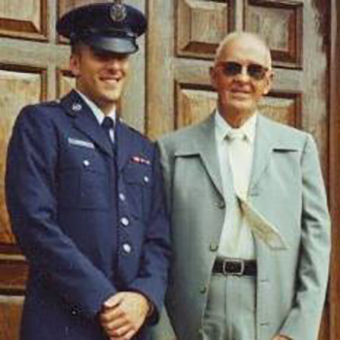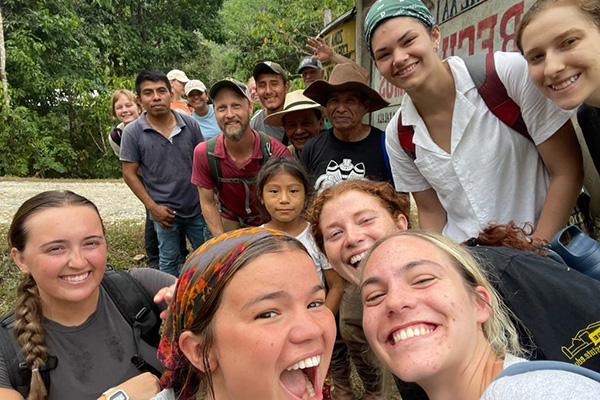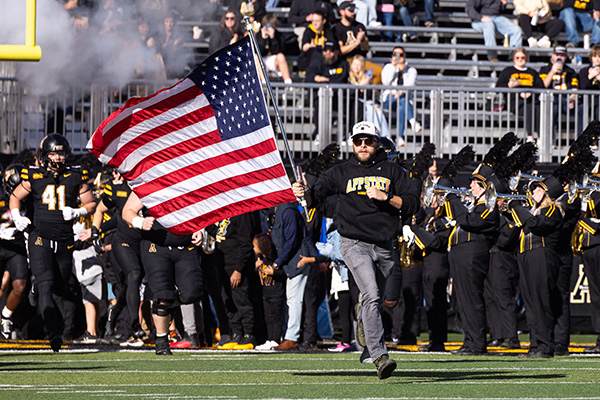BOONE, N.C. — Each Memorial Day, Appalachian State University commemorates those who died while serving in the U.S. military with a wreath laying at the campus Veterans Memorial, located next to the B.B. Dougherty Administration Building.
This year, Chancellor Sheri Everts selected Mike Waters, an Air Force veteran and a 20-year employee of App State, to place a wreath at the memorial, which honors App State students, faculty and staff who died while in service. Waters is a lead consultant for Copier and Printing Services in App State’s Information Technology Support Services.
“This gives me a chance to continue to educate all generations on the understanding of remembrance for those who paid the ultimate price for our freedoms,” Waters said. “I am no hero, but I am proud to honor those who are. Having the opportunity to recognize those sacrifices that secured our freedoms, I am thankful to have been selected.”

Mike Waters, a lead consultant for Copier and Printing Services in App State’s Information Technology Support Services and an Air Force veteran, is pictured in spring 1993 as he finished basic training at Lackland Air Force Base in San Antonio, Texas. He placed a wreath at App State’s Veterans Memorial for the Memorial Day remembrance on May 27. Photo submitted

Air Force veteran Mike Waters, a lead consultant for Copier and Printing Services in App State’s Information Technology Support Services, shares a photo of his grandfather, Paul Williams, along with Williams' memorial flag. Waters’ grandfather served in the Navy during World War II, in Okinawa, Japan, where Waters served in the late ’90s. Photo by Chase Reynolds
Waters, a Boone native, served as a communications-computer systems operator with the United States Air Force, and he achieved the rank of senior airman. His military service stretched from 1993 to 2000 — what he refers to as the “between war” years. Coming from a family of United States Navy veterans, Waters departed from tradition by joining the Air Force, but it was important to him and his family that he chose to serve in the military.
“The call to join and be selfless in my service to those who count on us to defend their freedom — especially my family — drove me to serve,” he said. “Serving allowed me to develop another family.”
Waters started his time in the military at Keesler Air Force Base in Mississippi and entered technical school. After completing school, his first assignment was a three-year tour in Okinawa, Japan, a place holding a special meaning in his heart.
“In Okinawa, I met three airmen who became my ‘brothers,’ and that bond is unbreakable today,” Waters noted. “However, Okinawa has an even deeper connection for my family — my grandfather served in Okinawa during World War II. I was able to walk the ground that he walked. I saw places he saw. That was an amazing experience.”

Mike Waters, a lead consultant for Copier and Printing Services in App State’s Information Technology Support Services, left, is pictured with his grandfather, Paul Williams, a World War II Navy veteran in 1993. Waters was getting ready to leave for his first duty assignment in Okinawa, Japan, where his grandfather had served in WWII. Photo submitted

Air Force veteran Mike Waters is pictured taking his two-stroke van to be inspected at Toma’s Garage in Okinawa, Japan, in 1995. Waters, now a lead consultant for Copier and Printing Services in App State’s Information Technology Support Services, placed a wreath at App State’s Veterans Memorial for the Memorial Day remembrance on May 27. Photo submitted
After serving in Okinawa, Waters was stationed at Malmstrom Air Force Base in Great Falls, Montana, before being deployed for a tour in the Middle East — visiting the United Arab Emirates, Saudi Arabia and Qatar. Due to a family illness, Waters made the difficult decision to shorten his military career to come home and help his family, but he began a new chapter at App State.
“I started a 20-plus year career here with New River Light and Power; now I am a lead consultant for our Copier Services program in IT,” he said. “It has been an adventure.”
Becoming a part of the App State family has supported Waters in continuing his connections to the military. He remains active on campus with the Military Affairs Committee and Student Veteran Resource Center and volunteers with App State’s Office of Community-Engaged Leadership.
“Being involved in these great campus organizations has allowed me to work with students and help them grow into the next generation of leaders in society,” Waters said. “Working with student veterans has allowed me to continue to connect with my military heritage and help develop the support network that military families come to rely on throughout their service.”

Mike Waters, a lead consultant for Copier and Printing Services in App State’s Information Technology Support Services, far right, enjoys dinner with his “Air Force brothers.” Pictured with Waters, from left to right, are Trey Buie, Bryan Moffitt and Tim Clark. Photo submitted

Mike Waters, a lead consultant for Copier and Printing Services in App State’s Information Technology Support Services, third from right in the back row, volunteers with App State’s Office of Community-Engaged Leadership. Waters is pictured with a team of students he led to Nags Head in fall 2017 as part of a Seaside Sustainability program. Photo submitted
What do you think?
Share your feedback on this story.

Photo of the St. Francis’s satyr butterfly. Photo courtesy of U.S. Fish and Wildlife Service
By Joseph Bathanti
University announces new emergency scholarship for student veterans
About Information Technology Support Services
Appalachian State University’s Information Technology Support Services, part of Information Technology Services, provides computing service, support and consultation to App State’s faculty, staff and students. Additionally, IT Support Services designs, implements and troubleshoots technology solutions for App State, providing a standard set of hardware and software application recommendations. Learn more at https://support.appstate.edu.
About Appalachian State University
As a premier public institution, Appalachian State University prepares students to lead purposeful lives. App State is one of 17 campuses in the University of North Carolina System, with a national reputation for innovative teaching and opening access to a high-quality, cost-effective education. The university enrolls more than 21,000 students, has a low student-to-faculty ratio and offers more than 150 undergraduate and 80 graduate majors at its Boone and Hickory campuses and through App State Online. Learn more at https://www.appstate.edu.













